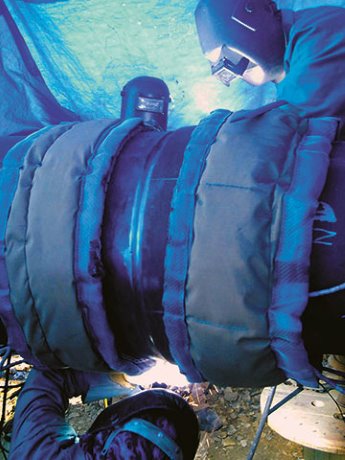Steel pipelines carrying oil and gas from Alberta and British Columbia pass through some of Canada’s most rugged territory and inclement weather.
Assembling and welding these pipelines requires plenty of heat, supplied by a host of subcontractors specializing in that service.
Energy producer Encana Corporation requires the application of considerable heat energy on its large-diameter steel pipeline, which may be required to transmit gases as hot as 100 degrees C at its Horn River shale gas operations, two hours north of Fort Nelson, B.C.
“In winter, we deal with temperatures as cold as –50 degrees C, so the differential between installation temperature and operating temperature could be 150 degrees C if we didn’t pre-heat the pipe prior to backfill and tie-in,” says Wayne Machan, pipeline supervisor with Encana.
The amount of heat required is calculated according to Section 4 of CSA Standard Z662 for pipeline construction.
Machan typically employs heating contractor Artic Therm International Ltd. with head office in Morinville, Alta. to distribute heat evenly along pipe as long as one kilometre.
The sub-contractor provides a fleet of mobile heaters, which agitate hydraulic oil to create flameless heat.
Pre-heating typically begins the night before tie-in and the results of heating are visually dramatic.
“You can see the length of the pipe growing along the ditch as heat is applied,” says Machan. “We want that to happen prior to the welding and tie-in, not after the pipeline is placed underground and carrying hot gas. If you need to cut off a section of pipe being heated, it will actually emit a loud bang as it contracts.”
Machan notes that effective pipeline heating is something of an art.
“We have different lengths of pipe at different diameters, with some insulated by polyurethane and some uninsulated,” he says. “The trick is to heat the pipe to the specified temperature, and maintain that heat consistently along the length of pipe to the back end using blowers and whatever engineering is necessary to maintain that consistency over the time required to weld the pipe.”
Heilix Oilfield of Bonnyville, Alta. provides a host of contractor services, including pipe-cutting, and hydro testing. About half its efforts involve induction coil heating of steel pipes as large as 36 inches in diameter to optimize pipe welding.
“We place ceramic pads on the pipe and then induce an electric current into the pads using a 200-kilowatt generator,” says Helix manager, Shawn St. Denis. “Depending on the welding company, we bring the pipes up to a temperature of between 200 and 300 degrees Fahrenheit.”
The contractor also offers post-weld heat-treating.
“On certain pipes, depending on thickness, the welds can become hard and brittle due to the heat applied,” he says. “After the job has been X-rayed, we reheat the weld almost to the melting point. The heat also provides stress relief to the structure of the pipe.”
St. Denis notes that pre-heating steel pipes requires the contractor to provide constant heat throughout the entire welding process.
“If the welders wanted to stop for a coffee break, the pipe will still remain at exactly the right temperature when they return,” he says.



Recent Comments
comments for this post are closed